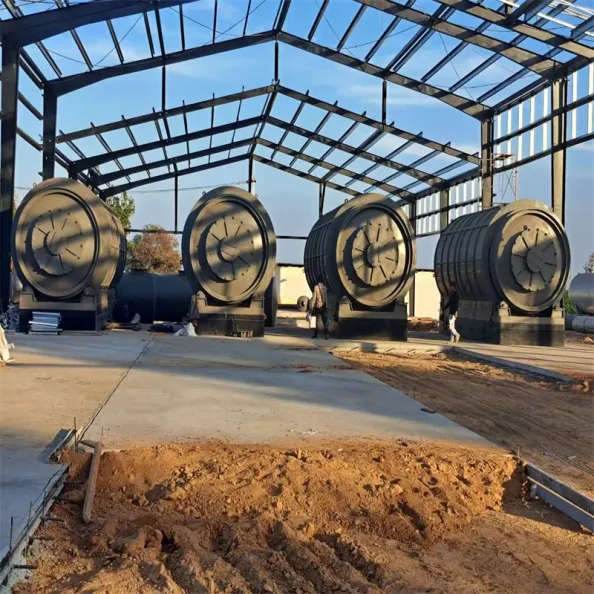Interpretation of Garbage Pyrolysis Furnace Technology
Dec. 20, 2024
With the rapid development of urban construction and new rural construction in my country, the output of domestic garbage is increasing day by day, especially the centralized treatment of rural and township garbage in the urban solid waste treatment system, which consumes a lot of transfer equipment and transportation costs, and also brings secondary pollution during operation. Therefore, decentralized on-site treatment of township and rural garbage is the way out.
At present, some township garbage adopts simple on-site landfill and incineration treatment, which is not environmentally friendly and wastes a lot of land resources. The use of garbage pyrolysis furnace to treat garbage is more in line with the principles of energy recycling economy of reduction, harmlessness and resource utilization. It adopts high-temperature pyrolysis gasification furnace + secondary combustion chamber + energy utilization system, which has been well received in landing projects across the country. The original patented furnace structure technology and the original patented secondary combustion chamber technology make the equipment efficient and control pollution at the source. The pyrolysis gas can be fully and stably burned in the secondary combustion chamber, with the highest temperature reaching 1300℃, and the pollutants are fully cracked at high temperature. Pyrolysis gasification and secondary combustion do not require any fuel and energy, achieving environmentally friendly, efficient, safe and stable energy utilization.

Pyrolysis and gasification principle: Garbage pyrolysis and gasification refers to the process in which the macromolecules of the organic components in the garbage break under oxygen-free or oxygen-deficient conditions to produce small molecular gases, tars and residues. Garbage pyrolysis and gasification technology not only achieves the harmlessness, reduction and resource utilization of garbage, but also effectively overcomes the dioxin pollution problem caused by garbage incineration. Garbage pyrolysis and gasification can be divided into two stages: the primary reaction stage: under heating conditions, the combustible solid waste first undergoes a cracking process to precipitate volatile matter, tar and methane and other gas products. The primary reaction stage is the main reason for the weight loss of the initial reaction. The secondary reaction stage: as the temperature rises, the macromolecular substances are cracked again to generate complex gases and methane and oxygen. The secondary reaction stage can be divided into small molecular substances, secondary reactions and macromolecular secondary reactions. Small molecular secondary reactions refer to the decomposition of ethylene, ethane, etc. into methane, hydrogen, etc. The macromolecular secondary pyrolysis reaction refers to the process in which compounds containing polyethylene rings, organic compounds, amino compounds, etc. are cracked again and decomposed into small molecular substances such as methane, benzene, water, and carbon. As the temperature rises, the secondary cracking intensifies, causing the gas production to increase rapidly. The ash from this pyrolysis gasification equipment can be directly landfilled, with low energy consumption and no need for any fuel. The flue gas emissions and wastewater emissions all meet national standards.
From the perspective of the garbage stratification inside the garbage pyrolysis plant, it is divided into four stages from top to bottom: drying layer, pyrolysis gasification layer, red charcoal layer, and ash layer. Red charcoal layer (combustion layer): an oxygen-deficient or low-oxygen environment, no open flames, a stable red charcoal layer of about 500mm thick, and a temperature of 600℃, providing stable heat energy for the upper gasification and drying. Pyrolysis gasification layer: The dried garbage absorbs the heat energy of the red charcoal layer and gasifies to produce hydrocarbon combustible gases such as H2, CO, CH4, and C2H6. Under oxygen-deficient conditions, when the temperature is between 500℃ and 600℃, the concentration of combustible gases reaches the best condition. C+CO2=2CO H2O+C=H2+CO C+2H2=CH4 CO+H2O=CO2+H2 Drying layer: The drying chamber is located at the top of the furnace body, and the flue gas is extracted from the top to accelerate the drying of the material. Ash layer: After the material in the red charcoal layer is fully burned, ash is formed. After high-temperature harmless treatment, it can be used as roadbed filler or fixed-point landfill. After normal use, a certain amount of ash is produced every day.
Compared with direct garbage incineration, pyrolysis gasification technology has the following advantages: (1) During the pyrolysis gasification process of the garbage slope, the organic components in the waste can be converted into different usable energy forms such as combustible gas and tar, which is more economical; (2) The air coefficient is low during garbage gasification, which greatly reduces the smoke exhaust volume, improves energy utilization, reduces the emission of nitrogen oxides, and reduces the investment and operating costs of flue gas treatment equipment; (3) Under the reducing atmosphere, the metal is not oxidized, which is easy to recycle. At the same time, metals such as Cu and Fe are not easy to generate catalysts that promote the formation of dioxins. (4) The flue gas produced by the pyrolysis gasification method contains less pollutants such as heavy metals and dioxins, which reduces secondary pollution, simplifies pollution control issues, and is safer for the environment.
203
0
0
None
None

Comments
All Comments (0)